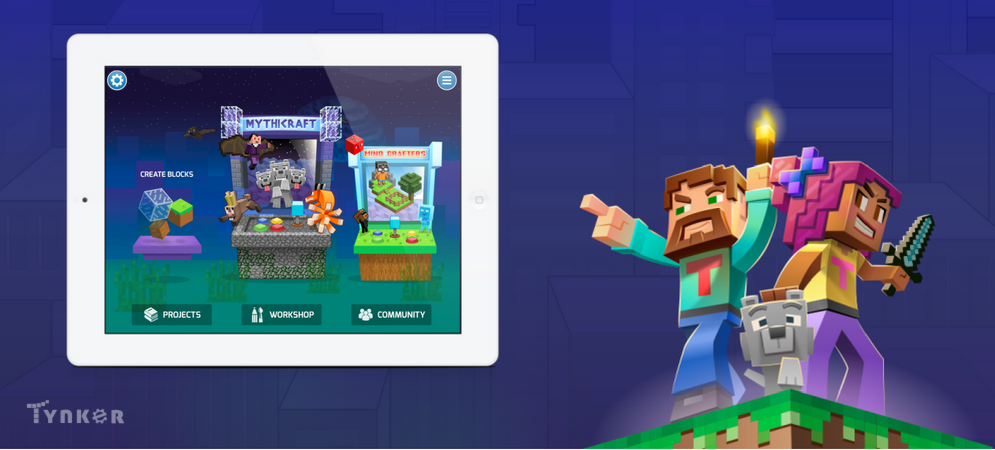
Table of Contents
Can Kids Learn to Code Before They Can Read?
It’s no secret that software is eating the world and that kids should learn to code as they prepare for their future. But how early should they start? At Tynker, we believe that coding is a skill that should be taught at the same time kids are learning to read and write. Tynker Junior, our new app does just that! In a series of well-designed adventures, pre-readers will learn to “tap” out computer code as they rescue endangered animals, build their own aquariums, and join a superhero league to fight villains.
Early engagement in scientific activities helps kids develop positive attitudes toward science, build up their STEM “vocabularies,” and problem-solve more effectively, according to research conducted by Google and Gallup. Furthermore, the key to getting more girls interested in STEM is to encourage and expose them to making. Tynker Junior includes adventures designed specifically for young kids, so that early learners learn basic programming concepts like sequencing, pattern recognition, loops, conditional logic, counters and events – the same coding concepts as mainstream programming languages like Swift, Python and JavaScript.
Getting Started with Icon Coding
Tynker Junior includes five exciting adventures with colorful characters that introduce coding concepts in a fun and engaging approach. Each adventure subtly introduces a computing concept and offers a series of critical thinking puzzles for kids to solve. This storytelling-based approach enables young children—who have limited motor skills and are still developing hand-eye coordination—to learn to code using big blocks, pictures, voiceovers and tap-tap-tap interactions, without words or drag-and-drop or any other actions they may find too tedious or overwhelming.

In Ocean Odyssey, beginners apply sequencing and pattern recognitions to collect coins and build their own aquariums. In Robots, kids learn to piece together wacky robots in a robot factory and learn about events and parameters. Wild Rumble introduces counting loops and delays, as they help save endangered animals. By the time kids complete Puffball Panic and Super Squad, kids are writing algorithms for multiple actors using loops and conditional logic.
Getting Creative with Studios
In the first part of the Tynker Junior app, kids are using code to solve puzzles. But as they enter the Studio section, kids have a chance to express their creativity in open-ended “sandbox” environments and write their own original code. These coding environments are specially designed so that they can get creative with the code blocks to build and save their first computer programs. The sandboxes feature friendly voice-enabled tutorials and help and easy icon code blocks to motivate kids to build whatever they can imagine!


The Art and Music Studio includes five sandboxes to explore. Octodrum and Rock Band allow kids to compose musical sequences with code. Wild Tracks, Seabed Scribbler and Starfish spirals provide a library of pen drawing blocks so that kids can explore creating geometric art using code. Animation Studio has four sandboxes to explore. In these sandboxes, kids design their own scenes, pose superheroes for picture day, create an emoji conversation, and even program their own robot dance.



The sandboxes are a great way for kids to apply coding concepts in real programs. For example, they use angles to create drawing patterns, loops and sequencing to compose music, and delays to simulate a conversation. They can save as many coding projects as they want for each sandbox. Parents are encouraged to see the solution guides that are available from the app and show sample code for a variety of scenarios.
Going Beyond Icon Coding
Kids who complete the above adventures will have a good understanding of coding concepts like sequencing, loops and conditional logic are ready to progress to the Tynker App and try Space Cadet and Dragon Spells. In Space Cadet. they help their astronaut navigate challenging paths, students learn sequencing, loops, conditionals and debugging skills. In Dragon Spells, as they guide a treasure-hunting dragon through a path filled with obstacles, students learn about functions, variables, and nested loops. In these courses, children learn to recognize patterns and break down problems into smaller steps.

From a desktop computer, kids can try courses such as Glitch Manor and Goblin Quest that reinforce a lot of the beginner coding concepts and then move on to intermediate level courses on game design, Minecraft modding and robotics. Beyond that, Tynker has a learning path with more advanced courses that teach them mainstream languages like Python, JavaScript as well as web development using CSS and HTML.
Coding is one learning activity you can take on-the-go or enjoy from the comfort of your home! Be sure your child is learning key 21st century skills like problem-solving, collaboration, and critical thinking through coding!
EXPLORE PLANS




